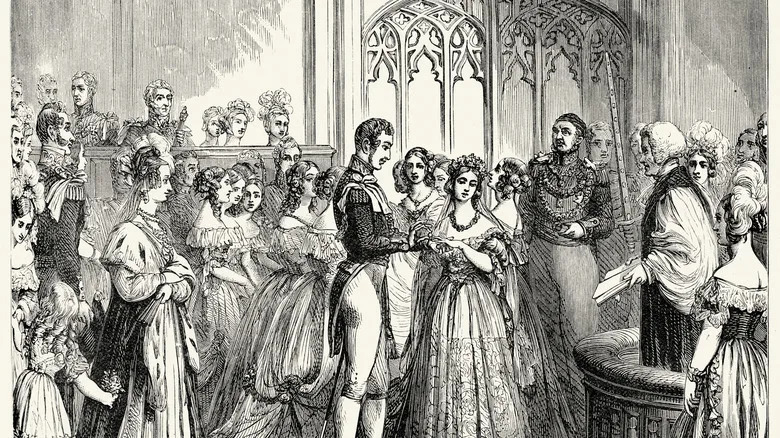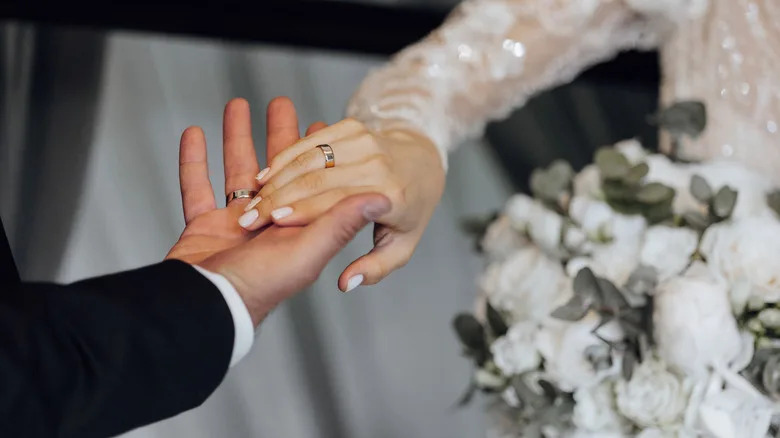British royal weddings are grand affairs, there is no doubt about it. From the opulent wedding dresses that inspire bridal fashion for years (if not decades) after the ceremony, to carriage rides that maneuver through throngs of adoring royal supporters, when a royal gets married, the world pays attention. There is no detail small enough to go unnoticed, and as with many British royal ceremonies, there is no detail small enough to be above tradition and ceremony. One such tradition is the royal wedding cake. Outside of one royal wedding, the 2018 union between Prince Harry and Meghan Markle, every royal wedding since 1840 has featured the same flavor of cake, and it probably isn’t what you’d expect.
Fruitcake, yes, the beloved (and loathed) cake often associated with Christmas time is the wedding cake of choice for the royal family. However, it isn’t exactly your grandma’s fruitcake, which might be found, even at this very moment, sitting in a tin in the back of her cupboards right now, a long forgotten relic of Christmas of 1983. No, this cake is much more opulent. Large enough to feed thousands of people, the royal wedding fruitcake is made with the highest quality ingredients, features rich, alcohol-soaked fruits, and a marzipan layer that is then coated in royal icing to finish. While the idea of a fruitcake for a wedding might still seem a bit odd, the wedding that started this tradition still impacts how we tie the knot today. So don’t knock it until you try it (and yes, you might very well be able to try it).
Read more: 11 Store-Bought Chocolate Cakes, Ranked Worst To Best
How The Tradition Of Wedding Fruitcake Started

Queen Victoria’s wedding – Duncan1890/Getty Images
So who do we, and the house of Windsor, have to thank for this royal wedding tradition? None other than Queen Victoria. Of course, to reduce the one and only Queen Victoria to her choice of wedding cake would be an insult to her vast and complex legacy. After all, she reigned over the British Empire during a time when it spanned the world over. The time in which she ruled, from the second half of the 19th century through 1901, is often referred to the Victorian age for good reason. She not only ruled a global empire, but influenced fashion, thought, and cultural traditions — and yes, that extends to weddings.
Her wedding to Prince Albert in 1840 began the tradition for fruitcake to be served at royal nuptials. The cake served at her wedding wasn’t a humble fruitcake, but a display of all of the edible riches her global kingdom had to offer. The cake was expansive, and there were plenty of leftovers, many of which were later sold off as keepsakes and souvenirs. In fact, slices of her cake still exist, and fetch a high sum at auction. So, if you have the funds you may very well be able to get a taste of her wedding day. You’d be surprised at how long fruitcake can hold up. In fact, you can revive fruitcake that’s been sitting for years. And while you may think Queen Victoria’s impact on weddings extends only to the rum-soaked dessert of royal wedding attendees, you’d be wrong. Chances are, you’ve probably attended at least one wedding with aspects inspired by the British royal.
Queen Victoria’s Lasting Impact On Weddings

Bride and groom holding hands – DocPhotos/Shutterstock
As it turns out, many wedding practices that we practice today either come from, or were popularized by Queen Victoria or came about during her eponymous era. Take the white wedding dress, for example. While she was of course not the first bride, or royal bride, to wear a white wedding dress, she did popularize the practice. The sumptuous gown, made of satin with lace details, was a departure from the velvet royal garb usually worn at the time, setting of sparks in England and across continental Europe. This spurred a widespread trend for white wedding dresses, which remain a ubiquitous wedding choice to this day. And though the contents of your wedding cake may vary from Victoria’s, what goes on top might come straight from her influence.
Her cakes is largely believed to have popularized wedding cake toppers, the miniature figures of the two spouses that go on the top tier of many wedding cakes. Her wedding cake featured figures of her and her husband Prince Albert atop their massive cake, which spawned a trend for the bride and groom figurines. Another Victorian wedding cake influence? The groom’s cake. While those outside of the Southern United States may not be familiar with the groom’s cake, it is a well worn wedding tradition that also spans the Victorian era in England. Though not originated by Victoria, it is nonetheless a product of the culture she fostered. So you see, we all carry a bit of Victoria’s memory with us, whether it be in white satin, sculpted in marzipan, or tucked into a tin box.
Read the original article on Chowhound.
